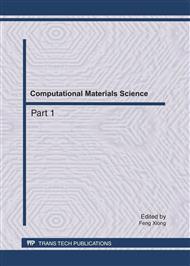p.51
p.56
p.61
p.67
p.72
p.76
p.82
p.88
p.91
Analysis of Crack-Inclusion Interaction in an Anisotropic Medium by Eshelby Equivalent Inclusion Method
Abstract:
The problem of a semi-infinite crack in anisotropic medium interacting with a near-tip inclusion is analyzed by the Eshelby equivalent inclusion method. The change of mode I stress intensity factor due to crack-inclusion interaction is evaluated using a novel analytical solution for the model I stress intensity factor at the tip of a semi-infinite crack due to near-tip eigenstrains. Numerical results of the mode I stress intensity factor due to the presence of a near-tip circular inclusion are presented to show the influence of the elastic stiffness of an inclusion on the near-tip elastic field. The present scheme can be applied to calculate the stress intensity at a crack-tip in anisotropic media due to the interaction of inclusions with arbitrary shapes.
Info:
Periodical:
Pages:
72-75
Citation:
Online since:
July 2011
Authors:
Keywords:
Price:
Сopyright:
© 2011 Trans Tech Publications Ltd. All Rights Reserved
Share:
Citation:


